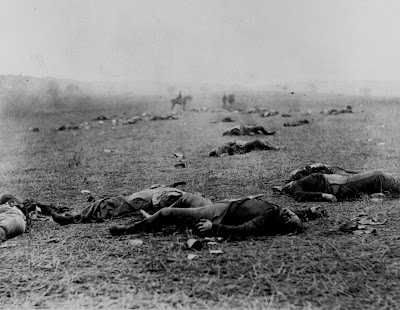
Roger Fenton, The Valley of the Shadow of Death
Roger Fenton, Portrait
One of the most famous nineteenth century war photographers is English born Roger Fenton whose Crimean War photographs picture large barren landscapes and intimate portraits of army generals and war officers. Fenton was born in Lancashire, England in 1819 and commissioned by publishers Thomas Agnew and Sons to documents England's war efforts in the Crimean Peninsula. When Fenton left for the Crimean, public opinion on the war was divided. Rumors that English soldiers were dying from starvation and poor living conditions spread rapidly throughout London's streets. Hence, Queen Victoria encouraged Fenton to capture "tasteful views of picturesque scenes," rather than imaging violence and warfare. Indeed, there was both a commercial interest (from the publishers) and a national interest (from the Queen) in Fenton's photographs. Although his images are striking and bold, they are be no means neutral; rather, they represent a contemporary agenda.

Roger Fenton, Fenton's Photographic Coach
Roger Fenton's success in the Crimean was due in part to his extensive planning and preparation. A few English photographers had left for the Crimean prior to Fenton's arrival, but all their negatives had been destroyed at sea or improperly fixed. Fenton's photographic caravan included 5 cameras, 700 glass plates (in three formats), lab Materials, and a bed. Nineteenth century war photography was not for the feeble. Fenton, who practiced the Wet Collodion process, had to travel in foreign terrain with an entire darkroom set-up and several large, bulky cameras.

Matthew Brady, from "The Brady Civil War Collection"

Matthew Brady, from "The Brady Civil War Collection"
When the American Civil War broke in 1861, the then famous portrait photographer, Matthew Brady, saw an opportunity to document history. In fact, Brady called himself the "eye of history." He received little support from the War Department but, nevertheless, managed to obtain the proper paperwork to place professional photographers in the fields alongside soldiers. Brady's team consisted of ten men, including Timothy O' Sullivan, Alexander Gardner, George N. Bernard, and George Cook. Brady and his team managed to shoot over 8,000 negatives, the majority of which can be found today in the National Archives under the "Brady Civil War Collection." Although Brady's photographers were present at most of the crucial battles (including Gettysburg, Antietem, and Petersburg), most of the photographs depicted the battle site before of after the fight. Exposure time and Nineteenth century aesthetic still prohibited photographers from successfully capturing warfare.

Alexander Gardner, from "The Brady Civil War Collection"
Historians have speculated that some of the Brady Civil War pictures were, in fact, staged. Like the Gardner photograph pictured above and the O’ Sullivan photograph pictured below, dead bodies were sometimes moved and repositioned in order to capture a more compelling image. Debates about the differences between psychological and physical truths have stirred many Civil War photo enthusiasts.

Timothy O' Sullivan, Harvest of Death, from "The Brady Civil War Collection"
Frustrated that Brady did not credit the individual photographers for the pictures that they made, Alexander Gardner published a book in 1866 called Gardner's Photographic Sketchbook of The War. In his book, Gardner included many of the great photographs of the time and attributed each photograph to its proper maker. In addition, Gardner wrote a text that accompanied the pictures. In response to O' Sullivan's image at Gettysburg, Gardner wrote, "Slowly over the misty fields of Gettysburg-- as all reluctant to expose their ghastly horrors to the light-- came the sunless mourn, after the retreat by Lee's broken army. Through the shadowy vapors it was, indeed, a "harvest of death" that was presented... such a picture contains a useful moral: it shows the blank horror and reality of war, in opposition to its pageantry. Here are the dreadful details! Let them aid in preventing such another calamity falling upon the nation!" Indeed, Gardner's text comments on the idea of psychological truth.



No comments:
Post a Comment